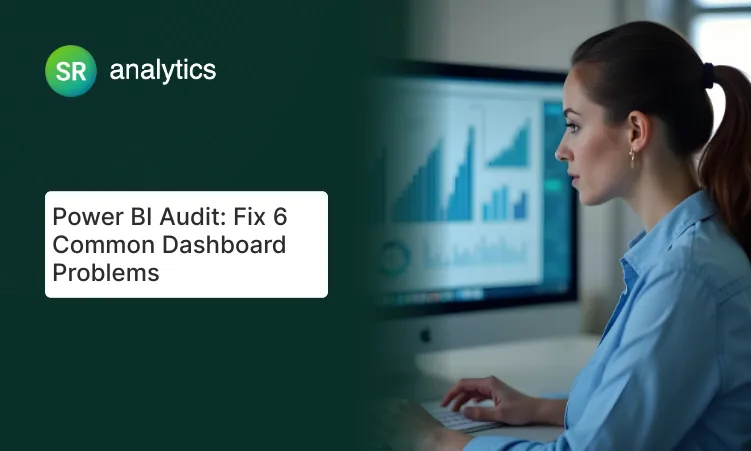Highlights
- Power BI’s flexibility can lead to shadow reporting and data risks.
- Step-by-step guide to secure rollout: governance, security, workspaces, access.
- Covers RLS, sensitivity labels, and structured workspace models.
- Emphasizes automation, training, and monitoring for long-term success.
- Real client example: HIPAA-compliant rollout in 30 days.
- Governance is the foundation—not a fix—for scalable Power BI.
Who This Blog Is For
This guide is tailored for CTOs, IT directors, Heads of Data, BI leads, and analytics managers tasked with deploying Power BI securely across departments.
Whether you’re overseeing enterprise-wide implementation or scaling Power BI within a mid-sized business, this roadmap will help you avoid common pitfalls—like report sprawl, compliance issues, or unscalable architecture—while laying a governance-first foundation.
Why Power BI Rollouts Fail Without Governance
Most Power BI deployments start informally: a finance analyst builds a dashboard, then shares it with sales. Another department duplicates it. Reports spread, often unmanaged, and no one knows which dataset is the source of truth.
To avoid such pitfalls, it’s essential to understand what Power BI is used for in business and why governance is foundational from day one.
- Uncontrolled Report Sprawl: Conflicting metrics across departments
- Security Gaps: Users accessing sensitive data without authorization
- Compliance Risks: No data lineage or auditability
- Performance Issues: Slow dashboards due to inefficient models or redundant data loads
According to Microsoft’s Power BI implementation guidance, “Failure to involve IT and governance from the start leads to scattered efforts, inconsistent data usage, and limited ROI.” Microsoft Learn
Governance is not a phase—it’s the foundation.
Step-by-Step: How to Implement Power BI Securely

Step 1: Define Your Governance Framework
- Assign Ownership: Define who governs Power BI—typically a steering committee with representation from IT, data owners, and business stakeholders
- Outline Responsibilities: Power BI admins oversee tenant settings; data stewards manage datasets; analysts create reports under predefined rules
Document Policies: Establish naming conventions, approval processes, and content lifecycle guidelines

Without these elements, the environment quickly becomes chaotic and insecure.
Best Practice: Begin governance with a charter document that outlines the purpose, roles, and enforcement mechanisms.
Step 2: Set Up Tenant-Wide Security Policies
- Use Azure Active Directory (AD): Group users by department or function. Assign access based on security groups, not individuals
- Enforce MFA: Enable Multi-Factor Authentication across all Power BI access points
- Restrict Export/Sharing: Disable risky features like “Publish to Web” or unrestricted downloads for sensitive reports
- Set Sharing Defaults: Limit external sharing unless explicitly approved
Security settings should reflect your company’s compliance posture—HIPAA, GDPR, SOX, etc. Microsoft’s documentation recommends revisiting these controls quarterly.
“You can’t manage what you can’t secure.” — JourneyTeam
Step 3: Create a Workspace Structure That Scales
Organizing content functionally—like “Finance BI” or “Executive Dashboards”—helps reduce duplication and maintain clarity.
This is especially true when designing Power BI KPIs that guide decision-making across the organization.
- Structure by Function: Create workspaces like “Finance BI,” “Sales Ops,” or “Executive Dashboards”
- Dev/Test/Prod Separation: For enterprise users, use deployment pipelines to promote content from development to production
- Centralize Data Models: Host certified datasets in shared workspaces so reports can reuse them
A structured workspace model ensures access control, supports versioning, and avoids content duplication.
Pro Tip: Restrict workspace creation to a governance-approved group. Letting anyone create workspaces leads to fragmentation.
Step 4: Establish Data Access Rules & Sensitivity Labels
Security policies must go beyond access control.
Applying data governance best practices—like sensitivity labels, DLP rules, and audit trails—can safeguard both compliance and stakeholder trust.
- Implement Row-Level Security (RLS): Limit what users can see within reports
- Apply Object-Level Security (OLS): Hide tables or fields users shouldn’t access
- Classify Data with Sensitivity Labels: Use Microsoft Purview to label content as “Confidential,” “Internal,” or “Public”
- Set DLP Policies: Prevent users from sharing sensitive information externally
This step is especially critical for regulated industries.
“Governance without sensitivity labeling is like a seatbelt with no buckle.” — Collectiv
Step 5: Standardize Naming, Metadata, and Report Catalogs
- Use Consistent Report Names: e.g., “Sales_Revenue_YTD_Q2_2025” instead of “Final_Dashboard_v4_NEW.pbix”
- Metadata Fields: Include descriptions, report owners, and refresh schedules
- Maintain a Report Catalog: Document reports, datasets, and their lineage
Good metadata improves discoverability and prevents duplication. It also supports auditing and compliance checks.
Step 6: Automate Dataset Refresh and Alerting
- Schedule Dataset Refreshes: Align frequency with data update cadence
- Use Power Automate: Trigger alerts on refresh failures or performance degradation
- Monitor Gateway Health: Ensure on-premises data gateway is always operational
“Automation transforms governance from policy to practice.” — Softude
Step 7: Train and Onboard Users by Role
while analysts need deeper modeling knowledge.
This is where a clear understanding of business intelligence fundamentals becomes a cornerstone of enablement.
- Tailor Training: Executives need KPI dashboards; analysts need modeling workshops
- Build a Center of Excellence (CoE): A hub for best practices, support, and innovation
- Create Internal Documentation: Share how-to guides, governance policies, and FAQ pages
Remember, training isn’t a one-off event. Offer periodic sessions and update materials regularly.
Step 8: Monitor Usage with Admin Tools and Audit Logs
- Use Admin Portal Analytics: Track most viewed reports, least active users, and report refresh status
- Enable Audit Logs: Detect risky behavior—like report downloads from unauthorized users
- Establish a Review Cadence: Quarterly review of usage patterns, permissions, and compliance gaps
Continuous monitoring ensures your governance policies evolve with your usage.
The Role of Data Governance in Power BI Success
Data governance isn’t just about security—it’s a driver of strategic value.
- Reduce Duplication: One certified dataset replaces 20 conflicting versions
- Enhance Data Literacy: Users trust what they see and understand report lineage
- Increase Compliance Readiness: Audit logs and classification reduce regulatory risk
- Foster Collaboration: Shared standards streamline cross-functional analytics
“Good governance is invisible. It just feels like things work.” — Skypoint Cloud
SR Analytics Power BI Rollout Framework
| Phase | What We Do | Outcome |
|---|---|---|
| Discovery | Map data sources, usage patterns, and goals | Avoid tool overlap and shadow BI |
| Setup | Configure tenant settings and workspaces | Secure, scalable foundation |
| Governance | Define roles, policies, and access controls | Prevent sprawl and unauthorized access |
| Enablement | Train users and create support materials | Maximize adoption and reduce errors |
Our clients gain peace of mind and faster ROI by rolling out Power BI securely from day one.
Client Story – Secure Power BI in 30 Days
Industry: Healthcare (U.S.-based)
Problem: Departments were using disconnected Excel files and unsecured Power BI dashboards. Sensitive patient data was at risk, and reports conflicted across teams.
- Azure AD role integration
- Sensitivity labels for HIPAA compliance
- Certified datasets and workspace structure
Result: Unified reporting across 4 departments in under 30 days—with zero compliance violations during external audit.
Our healthcare client rolled out a HIPAA-compliant Power BI environment in just 30 days. For more on how SR Analytics is transforming care with data, read this example of real-time, AI-driven operations in healthcare
Final Thought: Governance Isn’t Optional—It’s Strategic
The success of your Power BI rollout doesn’t hinge on visuals—it hinges on structure.
- Improve adoption without chaos
- Minimize security risks and compliance costs
- Create trusted, reusable analytics assets
Secure your Power BI rollout from day one. Don’t treat governance as a patch—build it into your foundation.














